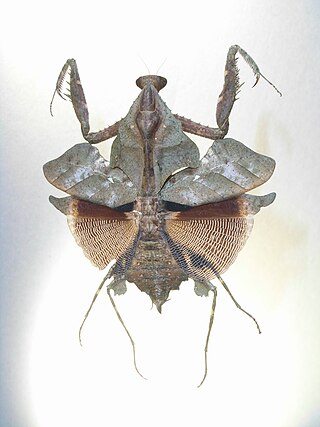
The Chinese mantis is a species of mantis native to Asia and the nearby islands. In 1896 this species was accidentally introduced by a nursery tender at Mt. Airy near Philadelphia, United States. Tenodera sinensis often is erroneously referred to as Tenodera aridifolia sinensis because it was at first described as a subspecies of Tenodera aridifolia, but Tenodera sinensis is now established as a full species.

The red river hog or bushpig, is a wild member of the pig family living in Africa, with most of its distribution in the Guinean and Congolian forests. It is rarely seen away from rainforests, and generally prefers areas near rivers or swamps.

Extatosoma tiaratum, commonly known as the spiny leaf insect, the giant prickly stick insect, Macleay's spectre, or the Australian walking stick, is a large species of Australian stick insect endemic to Australia. The species has the Phasmid Study Group number PSG9.

Flower mantises are praying mantis species that use a special form of camouflage referred to as aggressive mimicry, which they not only use to attract prey, but avoid predators as well. These insects have specific colorations and behaviors that mimic flowers in their surrounding habitats. This strategy has been observed in other mantises including the stick mantis and dead-leaf mantis. The observed behavior of these mantises includes positioning themselves on a plant and either inserting themselves within the irradiance or on the foliage of the plants until a prey insect comes within range. Many species of flower mantises are popular as pets. The flower mantises are non-nocturnal group with a single ancestry, but the majority of the known species belong to family Hymenopodidea.

Sundevall's roundleaf bat, also called Sundevall's leaf-nosed bat, is a species of bat in the family Hipposideridae.

Phyllocrania paradoxa, common name ghost mantis, is a small species of mantis from Africa remarkable for its leaf-like body. It is one of the three species in the genus Phyllocrania. It is known for its distinct and exclusive camouflaged appearance of a dry weathered leaf.

Litaneutria minor, or the agile ground mantis, is native to the drier regions of North America. L. minor is found in the United States in Colorado, Arizona to Mexico, and the eastern regions of Washington to California. They also can be found in Canada in the southern Okanagan Valley and are Canada's only native mantis. They are very active hunters and will be seen running across the ground from early spring to late summer.
Deroplatys desiccata, known by the common name giant dead leaf mantis, is a praying mantis from Southeast Asia. This is the type species of genus Deroplatys.

Deroplatys lobata, common name Southeast Asian dead leaf mantis or dead leaf mantis, is a species of praying mantis that inhabits Thailand, Java, Borneo, Indonesia, Sumatra and the Malay Peninsula.

Idolomantis is a genus of praying mantises in the family Empusidae. It is represented by a single species, Idolomantis diabolica, commonly known as the devil's flower mantis or giant devil's flower mantis. It is one of the largest species of praying mantises, and is possibly the largest that mimics flowers

Pseudoharpax virescens, common name Gambian spotted-eye flower mantis, is a species of praying mantis native to western, central and eastern Africa. It takes its name from two eye spots on the dorsal side of the abdomen of adult females.

Empusa pennata, or the conehead mantis, is a species of praying mantis in genus Empusa native to the Mediterranean Region. It can be found in Portugal, Spain, southern France, Italy and on the mediterranean coasts of Morocco, Algeria, Tunisia, Libya and Egypt. Because of its cryptic nature, or also possibly because of its fragmented, low density populations, it is rare to encounter in the wild.

Orthodera novaezealandiae, known as the New Zealand mantis or the New Zealand praying mantis, is a species of praying mantis which is, as both the scientific name and common names suggest, indigenous and endemic to New Zealand.

Choeradodis strumaria, common names leaf mantis and hooded mantis, is a species of praying mantis native to French Guiana, and neighboring countries, such as Suriname.

Empusa fasciata is a species of praying mantis in the genus Empusa in the order Mantodea.

Pseudocreobotra wahlbergii, or the spiny flower mantis, is a small flower mantis native to southern and eastern Africa.
Acanthops falcata, common name South American dead leaf mantis or boxer mantis, is a species of praying mantis in the subfamily Acanthopinae of the family Acanthopidae and is one of many praying mantises from various genera that resembles a dead leaf.

Mantises are an order (Mantodea) of insects that contains over 2,400 species in about 460 genera in 33 families. The largest family is the Mantidae ("mantids"). Mantises are distributed worldwide in temperate and tropical habitats. They have triangular heads with bulging eyes supported on flexible necks. Their elongated bodies may or may not have wings, but all Mantodea have forelegs that are greatly enlarged and adapted for catching and gripping prey; their upright posture, while remaining stationary with forearms folded, has led to the common name praying mantis.

Sibylla is a genus of mantises in the family Hymenopodidae and characteristic of the subfamily Sibyllinae.

Pnigomantis is a genus of mantises in the family Mantidae. It is monotypic, being represented by the single species Pnigomantis medioconstricta common name Indonesian double shield mantis or double shield mantis.



















